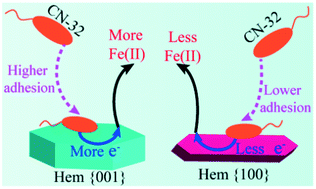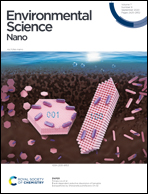Facet-dependent reductive dissolution of hematite nanoparticles by Shewanella putrefaciens CN-32†
Abstract
Dissimilatory iron-reducing processes can be influenced by the physicochemical properties of iron (Fe) oxides; however, little is known about the effect of the exposed facets of these oxides on the reductive dissolution process. In this work, kinetic studies showed that the reduction rate of hematite {001} by Shewanella putrefaciens CN-32 was faster than that of hematite {100}. XRD, HR-TEM, electrochemistry, and time-resolved ATR-FTIR spectroscopy combined with 2D-COS were used to investigate the interaction of CN-32 and different facets of hematite. Results showed that hematite {001} exhibited higher conductivity and lower resistance than hematite {100}, and therefore hematite {001} was more favorable for Fe bioreduction. This result was additionally supported by the higher current density observed in the DPV and Tafel results. The number of surface hydroxyl groups and the bacterial adsorption capacity of hematite {001} were both higher than the counterpart values of hematite {100}, and the redox potential of hematite {001} was more positive than that of hematite {100}. Hence, the more surface reaction sites and stronger oxidizing surface of hematite {001} accounted for higher iron reduction rates. During the biotransformation process, the produced Fe(II) was mainly distributed in the solution and adsorbed onto the Fe oxides. The adhesion amount of CN-32 on hematite {001} was higher than that on hematite {100}. Phosphorus functional groups play an important role in the adhesion of CN-32 on the facet-dependent hematite nanoparticles, and hematite {001} with its positive charges exhibited a stronger affinity to the CN-32 cell surfaces than hematite {100} with negative charges. Furthermore, the adhesion sequence of the bacterial functional groups on the hematite nanoparticles was influenced by the exposed facets of Fe oxides. This study advanced our understanding of the underlying mechanism for the microbe–Fe mineral interaction at the molecular scale.

- This article is part of the themed collections: Nano-bio interactions and Environmental Science: Nano Cover Art


 Please wait while we load your content...
Please wait while we load your content...